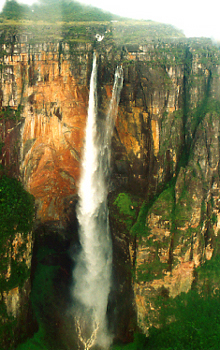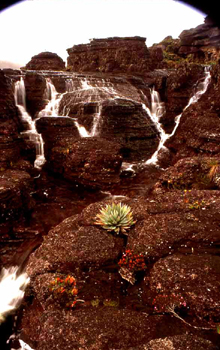About
Angel Falls
Angel
Falls has an upper section where it emerges briefly from the slot canyon,
plunges 100 feet or so and then goes into a cave or a crevice and emerges
again below about 150 feet or so to take the long drop. It is extremely
treacherous to move around in this area as even the short drop would kill
you easily X3. You have to be anchored down when standing around the top
of the falls.
That leads to the second consideration, that the falls at high water creates
its own weather. There are tremendous gusts of wind and waves of spray
that is created by the first and second part of the falls crashing against
the rocks and into the cave. Great gusts of wind emerge both above and
below the cave. It is a pretty unique situation as you might expect
from the world's highest waterfalls. From a distance you only see one
great falls, but close up you can see a series of canyons, tunnels, and
caves into which the falls enter and emerge several times at the top.
In medium or high water this area is extremely violent with high unpredictable
winds and waves of spray as I mentioned. The base jumpers always jump
at low water to avoid the high winds. Some of the best jumpers in the
world jumping under the very best of conditions have been killed there
anyway.In the western
part of Canaima National Park, is the Auyantepuy, one of the largest and
better known "tepuy" (A flat top mountain ending with vertical
walls). From this tepuy is where the Angel falls are formed. The fall
is 979 meters high (around 3000 ft.), and is the higher waterfall in the
world.
The Angel Falls were named after the american aviator that discovered
them in 1937. However, the local indians, the Pemones, already knew it
and called it the Churún Merú.
Angel Falls
Spills from the Auyantepui into what is known as the Devil's canyon 979 Meters below. The local indians call it Kerepakupai-merú but is was named Angel Falls after Jimmy Angel, an American bush pilot and gold-hunting adventurer, who discovered it in 1937. The waters fall freely some 807 meters (2,648 feet) and reach the bottom of the valley as a misty spray that gathers into a small creek which eventually finds its way into the north-bound Churun River.
The Natives in Venezuela had known about the "Salto Angel" since
the beginning of time. Then United States pilot Jimmie Angel was flying
over the area in 1935 when he landed on the top of a lone mountain in
search of gold. His plane got stuck in the boggy jungle on top of the
mountain and he noticed a pretty impressive waterfall plunging thousands
of feet down. He wasn't too happy about the 11 mile hike back to civilization,
and his plane remained stuck and rusting upon the mountain as a monument
to his discovery. Soon the whole world would know about the falls, which
came to be known as Angel Falls, after the pilot who "discovered" them.
Angel Falls plunges from the top of a mesa, or what the natives call a
Tepuyi. Named "Auyantepui", the Angel Falls mesa is one of over
a hundred of its kind which are scattered about the Guiana Highlands of
southeast Venezuela. Like so many slumbering giants, what characterizes
these mesas (Tepuys) is their massive heights soaring up towards the sky,
each with a flat top and totally vertical sides (check out the picture
at left). Also called "table mountains" (which accurately describes
their shapes) these Tepuys were formed out of sandstone billions of years
ago. Their vertical sides are continually being eroded by the action of
water from the heavy rainfall the Guiana Highlands gets.


For more information contact:
Richard D. Fisher
P.O. Box 86492
Tucson, AZ 85754
Phone: (520) 882-5341
Email: sunracer@theriver.com